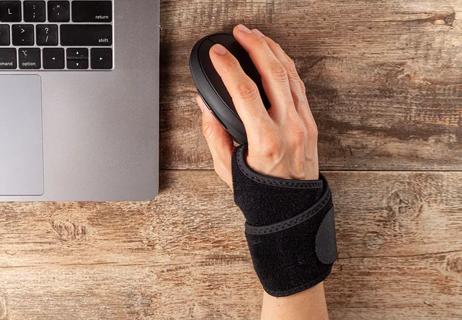Finding relief starts at getting a proper diagnosis

Feeling pins and needles. Tingling. Swelling. Numbness.
Cleveland Clinic is a non-profit academic medical center. Advertising on our site helps support our mission. We do not endorse non-Cleveland Clinic products or services. Policy
No matter which of these symptoms you suffer from, they’re often an early warning sign of carpal tunnel syndrome — especially if your symptoms are in the thumb, pointer and middle finger, says rheumatologist Scott Burg, DO.
“Not all hand pain is carpal tunnel syndrome, of course,” says Dr. Burg. “It’s a very specific nerve issue with telltale signs. When the carpal tunnel, a passageway in your wrist, becomes too crowded because of inflammation or compression, you get pressure on your median nerve.”
On top of those nighttime sensations, you may also have tingling during the day and numbness in your fingertips. Over time, the muscles in your hand will weaken, leading to difficulty with grip.
If this sounds like you, it’s time to consult your doctor. It’s worth ruling out other hand or wrist issues to get the proper treatment.
Reaching out to your doctor is the best first step you can take to find relief. Expect a few possible tests during a doctor’s visit:
Your doctor will also ask about your overall health because diabetes, rheumatoid arthritis, an overactive thyroid and other conditions often go hand-in-hand with carpal tunnel. Pregnancy and heredity play a part, too.
“On the whole, treatment will target the symptoms of carpal tunnel syndrome,” says Dr. Burg. “But it’s important to know how it fits into the big picture. For example, if you have rheumatoid arthritis, treating it may reduce your carpal tunnel symptoms, too.”
Have you ever noticed that the pain starts when you’re trying to sleep? That’s because symptoms usually begin at night.
“It’s tough to control your wrists while you sleep,” says Dr. Burg. “That’s why many patients have nighttime symptoms. Wearing a wrist splint can make a big difference because it keeps your wrists straight, avoiding pressure on your nerve.”
If you can wear them for your job, wearing splints during the day may help, too. Although carpal tunnel can happen on any job, repetitive activities — like typing on a computer keyboard or working on an assembly line — can take a toll, especially if your form is improper.
That’s where an occupational therapist (OT) can help. An OT can not only improve your workstation to avoid stress and strain, but they can also help you change the way you move your hands and wrists.
“You can try anti-inflammatories for pain relief, too, but the relief they provide may be minimal,” he says. “The same is true of ice. Icing other types of hand or wrist conditions provides relief, but the issues with carpal tunnel are often deep enough that ice won’t offer much help.”
The National Institute of Neurological Disorders and Stroke recommends talking to your doctor about prescription medicine or alternative therapy like acupuncture of chiropractic care.
If wearing splints and changing your movement doesn’t help, your doctor may recommend cortisone injections.
“For many, injections provide relief for months or even years,” says Dr. Burg. “But these shots can weaken tissue over time, so we don’t use them for extended time periods. We typically won’t recommend more than two in a year.”
In more severe cases, surgery may be your best option. The good news is carpal tunnel release surgery is common, has a high rate of success and is usually done under local anesthesia. Most people can return to regular activities within six weeks.
If you do need surgery, your doctor may recommend that you wear a splint for a while afterward. Working with an OT afterward can help with recovery, along with altering your habits at work to help you take the strain off for the future.
Learn more about our editorial process.

These movements can help with pain, numbness and tingling in your hands and fingers

7 tricks to try to ease the tingling pain

Here’s what you need to know about the bony protrusion on your hand

Desk work doesn’t have to leave you hurting

The Short Answer from an orthopaedic surgeon

The answer varies from person to person and vaccine to vaccine

Learn all you can, seek out support and don’t be afraid to advocate for yourself

From nausea, weight gain and eczema, stress can affect your immune system in many ways

Your metabolism may torch 1,300 to 2,000 calories daily with no activity

A gentle touch in all the right places may help drain your sinuses